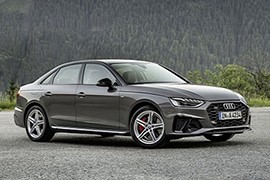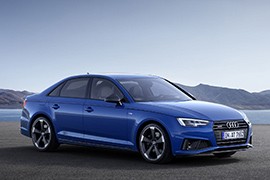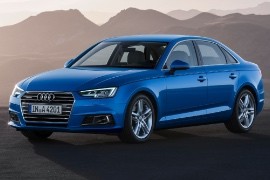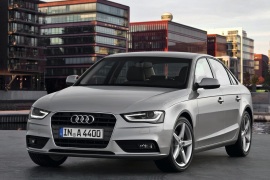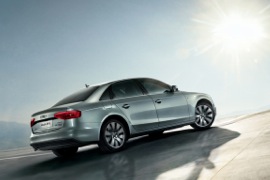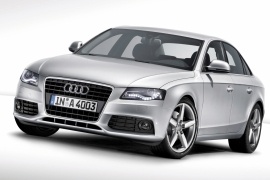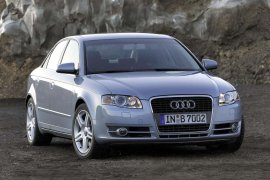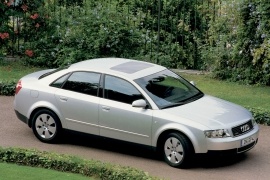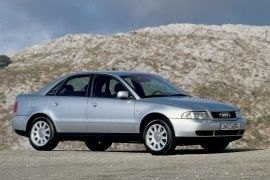AUDI A4 Models/Series Timeline, Specifications & Photos
First production year: 1994
Engines: Diesel, Gasoline, Mild hybrid, Ethanol
Audi introduced the fifth generation of the A4, also known as the 8W in the carmaker's terminology, in 2015, upgrading it once in 2018 and a second time for the 2020 model year.
The German automaker usually didn't make that many changes over one generation of its cars. It used to perform only one facelift after four years after the initial launch. But the A4 was an exception so, unlike the 2018 update, the 2019 refresh for the 2020 model year was significant.
On the front fascia was a new set of standard LED headlights with daytime running lights featuring six distinct LED blocks in each headlamp. Also, the single-frame grille was flatter and wider and with a reduced height. Thus, Audi could also redesign the lower part of the bumper, increasing the side of the lower air intake and thus reducing the drag coefficient. On the sides, the 2020 A4 sported new rear doors with a sculptured line on it that continued on the upper side of the quarter panels. Finally, at the back, there was a new taillights design, with horizontal reversing lights and an overall look that echoed the headlights.
Inside, the most significant upgrade was the touchscreen for the new MMI (Audi's infotainment system), which sat on top of the dashboard, tilted toward the driver. Its high-resolution TFT display provided acoustic feedback and had an increased resolution compared to the screen offered on the previous versions of the A4 8W. Moreover, thanks to the new system, the automaker could delete the controls from the center console. Customers could order the car with a choice of three instrument clusters: a part-analog/part digital panel, the Audi virtual cockpit, and a head-up display.
For the drivetrain, Audi implemented the MHEV technology on the entire A4 range, thus reducing fuel consumption. Depending on the engine and options, customers could get a seven-speed S-Tronic (dual-clutch) gearbox, an eight-speed automatic, or a six-speed manual with either front or all-wheel drive (quattro).
For the 2019 model, Audi refreshed the exterior design of its A4 and the midsize sedan became even more appealing.
No major changes were made in comparison with the previous A4, however, the premium looking car got a more aggressive front fascia.
The A4’s interior was sporty looking, with the 3-spoke multifunction steering wheel and sport leather seats for the S line package.
Standard for the 2018 A4 were parking sensors and xenon headlights, as well as a bluetooth connectivity.
The already known Audi Virtual Cockpit replaced the outdated analogue dials. The driver could use the sat-nav with the Audi Virtual Cockpit.
The A4 was a roomy car, with lots of storage spaces inside the cabin. The storage room in the door panels could hold a 1.5 L bottle. The glovebox was a little bit small.
The comfortable seats were not equipped with a lumbar support as standard.
The dimensions of the A4 increased compared to its predecessor, and that would be noticed in the rear passenger seats, where legroom and headroom was good for a long journey. However, 3 people in the rear seats would not feel comfortable.
The trunk volume was good and the square shape of it was practical. The foldable rear seats could increase the load area if needed.
The aerodynamics of the A4 was improved, the A4 was 21% more efficient and with 120 kg lighter than the previous A4.
The fifth generation of the Audi A4 was revealed in June 2015 and the official launch was carried at the Frankfurt Motor Show in the same year. It was lighter and bigger than its predecessor.
After the conversion from the Audi 80 to the A4, the premium compact-sedan model from Audi grew in size from 4520 mm (178”) to 4726 mm (186.1”). It was hardly a compact and more of a mid-size sedan vehicle. Its bigger brother, the A6, was 4797 mm (188.9”) in 1994.
From the outside, the 2016 A4 featured the big singleframe grille and a pair of headlights that resembled those on its bigger brother, the A6. The car was aerodynamically enhanced so the drag coefficient dropped to 0.23, which was the best in its class in 2016.
Inside, the fifth generation of the A4 was a true premium vehicle, featuring the Audi Virtual Cockpit for the instrument panel and a new, 8.3” monitor, infotainment display which was controlled via a touchpad on the center console. The car could have been connected to the Internet via the LTE network.
For the drivetrain, the A4 was available with a choice of diesel and gasoline-powered units, with four and six cylinders. Depending on the version, they were mated to a 6-speed manual, a 7-speed S-Tronic or an 8-speed Tiptronic gearbox. It was offered with a front or all-wheel-drive system.
Audi introduced the facelifted version of the A4's eighth-generation compact premium sedan in 2012, proving that the car could still sell in high numbers even after almost four decades since it launched this nameplate.
The German automaker had to revamp the model after the world financial crisis that ruined many other car manufacturers. Still, it didn't rush until it was sure that it could sustain production and also get some profit out of the new version.
At the front, the 2012 A4 sported the new design signature named single-frame that was boasted on the entire Audi range, with a chromed trim surrounding it. It was flanked by a pair of headlights that featured the LED daytime running lights inside the lamps. From its profile, the automaker chose to create a cab-rearward design, with a long hood and a short deck at the back behind a sloped-down rear windscreen.
Since the automaker tried to convince customers that it was more of a sports sedan, it installed bolstered front seats and a bench seat profiled for two in the back. On the dashboard, the 2012 A4 featured an integrated MMI (Audi's infotainment system) integrated into the same cluster as the instrument panel. A pair of large dials for the speedometer and tachometer fronted the driver and flanked an LCD that showed information from the onboard computer.
For the drivetrain, the A4 Avant offered various diesel and gasoline engines and a powerful version as well: the S4. The sporty compact premium sedan was available either with a front-wheel-drive or an all-wheel-drive (quattro) system.
AUDI A4 1.8L TFSI 6MT (120 HP)
AUDI A4 1.8L TFSI 6MT (170 HP)
AUDI A4 1.8L TFSI CVT (120 HP)
AUDI A4 1.8L TFSI CVT (170 HP)
AUDI A4 1.8L TFSI quattro 6MT (170 HP)
AUDI A4 2.0L TFSI 6MT (225 HP)
AUDI A4 2.0L TFSI CVT (225 HP)
AUDI A4 2.0L TFSI quattro 6MT (180 HP)
AUDI A4 2.0L TFSI quattro 6MT (225 HP)
AUDI A4 2.0L TDI clean 6MT (150 HP)
AUDI A4 2.0L TDI clean CVT (150 HP)
AUDI A4 2.0L TDI clean quattro 6MT (150 HP)
AUDI A4 2.0L TDI quattro 6MT (150 HP)
AUDI A4 2.0L TDI quattro 6MT (177 HP)
AUDI A4 2.0L TDI quattro 6MT (190 HP)
AUDI A4 2.0L TDI quattro 7AT (177 HP)
AUDI A4 2.0L TDI quattro 7AT (190 HP)
AUDI A4 2.0L TDI ultra 6MT (136 HP)
AUDI A4 2.0L TDI ultra 6MT (163 HP)
AUDI A4 3.0L V6 TDI 6MT (204 HP)
AUDI A4 3.0L V6 TDI clean quattro 7AT (245 HP)
AUDI A4 3.0L V6 TDI CVT (204 HP)
Audi introduced in 2012 a long-wheelbase version for the A4 range in China and built it in the factory from Changchun.
Together with its local partner FAW (First Automobile Works), the German carmaker unveiled the refreshed fourth generation of the A4 on August 8th, 2012, at Qingdao. There were 40 changes or new elements in the A4 L compared with its non-facelifted sibling. The facelifted A4 also came with a long-wheelbase version, which Audi sold exclusively on the Chinese market.
At the front, the car received a new front fascia with new LED daytime running lights inside the headlamps. Its black, single-frame grille was adorned with a chromed surrounding trim, while the bumper featured two broad, side clusters for the fog lights. Audi made the A4 L with a 6 cm (2.4”) longer wheelbase than its standard version. That added length translated into longer rear doors.
Apart from the increased rear legroom, the A4 L featured a new, three-spoke design steering wheel, similar to the one installed in the Audi A5. Another change at the front was the new gear-lever, which sported a golf-club design carried over from the A6 L model (also available in China). The carmaker added heated seats (outbound), side and rear sunshades, plus three-zone climate control to increase the comfort in the back. On the safety side, the A4 L received adaptive cruise control with an automatic emergency braking function.
Under the hood, Audi installed a choice of four engines ranged between 160 hp and 272 hp. Apart from the five-speed manual gearbox, the carmaker added an option for CVT and a seven-speed (dual-clutch) automatic transmission for the two top versions.
The fourth generation of the Audi A4 B8 was a completely new car, compared to its previous generation B7, which was more of a facelift for the B6.
In 2007 Audi launched a new generation for its compact-executive car, the A4. It was built on a new platform that allowed the engine to be re-positioned to balance the mass distribution. That was the most important change.
The exterior design was different than on the B7, but not really that much. There were a different grille and different headlights design, but the overall shape was easy to recognize as an Audi A4. It had a 2.8-meter (110.6”) wheelbase and that made room for a longer greenhouse and a spacious interior. The beltline was high to improve the occupant's protection in the event of a side crash.
Inside, the driver had a lot of room and a lot of adjustments for the seating position. The instrument cluster featured a central red display for the on-board computer and a new infotainment unit was placed in the dashboard. It was accessible via a rotary knob on the center console. The rear seats had enough leg-room even for tall passengers.
From the technical point of view, the new MLB platform was designed to be used for the all-wheel-drive versions and also for the cross-over vehicles. It even allowed a longer wheelbase, required by the Chinese market. On top of that, there was a big variety of engines available and three transmissions: 6-speed manual, 6-speed Tiptronic (automatic) and a CVT. The latter was available only for specific engines and only on front-wheel-drive versions.
AUDI A4 1.8L TFSI 6MT (120 HP)
AUDI A4 1.8L TFSI 6MT (170 HP)
AUDI A4 1.8L TFSI CVT (120 HP)
AUDI A4 1.8L TFSI CVT (170 HP)
AUDI A4 1.8L TFSI Quattro 6MT (170 HP)
AUDI A4 2.0L TFSI 6MT (211 HP)
AUDI A4 2.0L TFSI CVT (211 HP)
AUDI A4 2.0L TFSI Quattro 6MT (211 HP)
AUDI A4 2.0L TFSI Quattro 7AT (211 HP)
In late 2004, Audi introduced the seventh generation of the A4. It was announced as a B7, but on its internal documents was named as a 6th generation. It was not a new car, but an extensive facelift.
The Audi A4 B7, as it is mainly known, it kept the same platform from its predecessor. A very good platform that was built for longitudinal engines. From the outside, it looked like a new car. The front grille had the same shape and inspiration theme as the bigger Audi A6. The headlights didn't have a straight line on their lower side. From the side, it was easy to recognize its predecessor. In the rear, the boomerang style taillights gave a different perspective. The overall length of the car was bigger than on its predecessor, but only due to a bigger rear bumper.
Inside, most of the elements were the same as in the 2001 Audi A4. There were some differences such as an aluminum trim sweeping across the dashboard. Since the wheelbase was almost the same, the interior room wasn't improved. It had a better sound system and different materials inside.
The engine lineup was improved extensively and, most important, the direct fuel injection system was widened across the gasoline engines too. A new, 6-speed manual transmission was introduced to replace the older 5-speed.
Riding on a new platform and with a look inspired by the Bauhaus design culture, the second generation of the Audi A4 was introduced in late 2000 at the Paris Motor Show.
By 2000, Audi already became a tough contender in the premium automotive market. The compact-segment was another area where it had to face stiff competition from the BMW 3-Series and the Mercedes-Benz C-Class. Its main advantages were the front-wheel-drive and all-wheel-drive systems, which were easier to use than the classic rear-wheel-drive systems.
The design was signed by Peter Schreyer, a former winner of the Audi Scholarship in the '80s. Its name became famous for the TT model and that was an inspiration theme for him. The A4 was a mix between the TT and the big brother A6 sedan. The narrow headlights and high-mounted taillights were specific for the Audi models from that era. The curved and flat surfaces kept a clean design, but not a minimalist one.
Inside, the idea of the exterior was continued with a flat and curved dashboard with a tilted center stack. It was easier to reach by both front passengers, unlike the driver-oriented one found on the BMW. The “keep-it-simple” idea worked well but some critics said that it was simple and boring at the same time. At least, the interior arrangement allowed decent legroom for the rear passengers. The headroom was limited for tall passengers.
From the engineering point of view, the second generation of the A4 was based on the new, B6 (PL46), platform. It featured longitudinally mounted engines and front, or all-wheel-drive systems. The base model featured a 1.6-liter gasoline engine, while the top version was powered by a 220 hp 3.0-liter V6 engine. The A4 was offered with a 5- or 6-speed manual and automatic transmission.
AUDI A4 1.8L T 5MT FWD (163 HP)
AUDI A4 1.8L T 5MT FWD C(150 HP)
AUDI A4 1.8L T 6MT FWD (190 HP)
AUDI A4 1.8L T CVT FWD (150 HP)
AUDI A4 1.8L T CVT FWD (163 HP)
AUDI A4 1.8L T CVT FWD (190 HP)
AUDI A4 1.8L T quattro 5MT FWD (150 HP)
AUDI A4 1.8L T quattro 6MT FWD (163 HP)
AUDI A4 1.8L T quattro 6MT FWD (190 HP)
AUDI A4 2.0L FSI 5MT FWD (150 HP)
AUDI A4 2.0L FSI CVT FWD (150 HP)
AUDI A4 2.4L V6 5MT FWD (170 HP)
AUDI A4 2.4L V6 CVT FWD (170 HP)
AUDI A4 3.0L V6 5MT FWD (220 HP)
AUDI A4 3.0L V6 CVT FWD (220 HP)
AUDI A4 1.9L TDI 5MT FWD (100 HP)
AUDI A4 1.9L TDI 5MT FWD (115 HP)
AUDI A4 1.9L TDI 5MT FWD (130 HP)
AUDI A4 1.9L TDI 6MT FWD (130 HP)
AUDI A4 1.9L TDI CVT FWD (130 HP)
AUDI A4 2.5L TDI 6MT FWD (155 HP)
AUDI A4 2.5L TDI 6MT FWD (163 HP)
AUDI A4 2.5L TDI CVT FWD (155 HP)
AUDI A4 2.5L TDI CVT FWD (163 HP)
Unlike its bigger brother, the A6, the first generation of the A4 was not a facelift and re-badged Audi 80. It was a true first generation of the new trend in Audi's cars lineup.
With the new model, Audi put a firm step into the premium-segment territory. To succeed against established brands such as the Mercedes-Benz and BMW, it had to come with a different approach. It was a different approach than the one used for the Audi 80.
The 1994 Audi A4 used the newly developed Volkswagen PL45 (B5) platform, which allowed longitudinal-mounted engines, front or all-wheel-drive. The engine was installed over the front axle, helping with the weight balance. The clear-lenses headlights were new for the compact-sedan built by Audi. A raked A-pillar and rounded greenhouse made the car look sleek. In the back, unlike the last 80 model, the trunk was ended with a sharp line.
Inside, the modern interior design greeted its owners with appealing shapes, rich textures, and polished walnut trim for specific trim levels. The bucket-seats with ample bolstering were designed for good support while hard cornering. Between the rear seats, a pass-through door was made for skis to be stored inside.
On the engineering side, the 1994 A4 featured the newest engines available in Audi's warehouse. The 1.8-liter unit with 5-valves per cylinder was installed and offered a good balance between fuel-efficiency and performance. More diesel and gasoline units were available. The 5- or 6-speed manual transmission was standard depending on the engine, while the new Tiptronic automatic transmission developed by Porsche was available. Most of the versions were available with all-wheel-drive system.
AUDI A4 1.9L DI 5MT FWD (75 HP)
AUDI A4 1.9L TDI 4AT FWD (110 HP)
AUDI A4 1.9L TDI 4AT FWD (90 HP)
AUDI A4 1.9L TDI 5AT FWD (115 HP)
AUDI A4 1.9L TDI 5MT FWD (110 HP)
AUDI A4 1.9L TDI 5MT FWD (115 HP)
AUDI A4 1.9L TDI 5MT FWD (90 HP)
AUDI A4 2.5L TDI 5AT FWD (150 HP)
AUDI A4 2.5L TDI 6MT FWD (150 HP)
